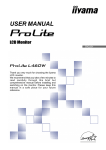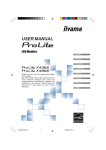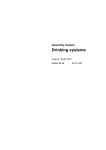Download iiyama PLL323W-S LCD TV
Transcript
USER MANUAL ENGLISH Thank you very much for choosing the iiyama LCD monitor. We recommend that you take a few minutes to read carefully through this brief but comprehensive manual before installing and switching on the monitor. Please keep this manual in a safe place for your future reference. FCC DECLARATION OF CONFORMITY Model Number: PLL403W / PLL323W Trade Name: Responsible party: iiyama IIYAMA North America, Inc. Address: Telephone number: 65 West Street Road, Suite 101B, Warminster, PA18974 U.S.A. 215-682-9050 This device complies with Part 15 of the FCC Rules. Operation is subject to the following two conditions: (1) This device may not cause harmful interference, and (2) this device must accept any interference received, including interference that may cause undesired operation. This device has been tested and found to comply with the limits for Class B Personal Computers and peripherals, pursuant to Part 15 of the FCC Rules. These limits are designed to provide reasonable protection against harmful interference when the device is operated in a residential environment. This device generates, uses and can radiate radio frequency energy, and if not installed and used in accordance with the instructions, may cause harmful interference to radio communications. However, there is no guarantee that interference will not occur in a particular installation. If you determine the device does cause harmful interference to radio or television reception (this may be determined by monitoring the interference while turning the device off and on), you are ENGLISH encouraged to try to correct the interference by one of the following measures: n Reorient or relocate the receiving antenna. n Increase the separation between the device and receiver. n Connect the device into an outlet on a circuit different from that to which the receiver is connected. n Consult the dealer or an experienced radio or TV technician for help. To meet the FCC requirements, you should use a signal cable with ferrite core at both ends. CAUTION Changes or modifications not expressly approved by iiyama could void the users authority to operate the device under FCC compliance regulations. CANADIAN DEPARTMENT OF COMMUNICATIONS COMPLIANCE STATEMENT This digital apparatus does not exceed the Class B limits for radio noise emissions from digital apparatus as set out in the radio interference regulation of the Canadian department of communications. CE MARKING DECLARATION OF CONFORMITY This LCD monitor complies with the requirements of the EC Directive 89/336/EEC “EMC Directive” and 73/23/EEC “Low Voltage Directive” as amended by Directive 93/68/EEC. The electro-magnetic susceptibility has been chosen at a level that gives correct operation in residential areas, business and light industrial premises and small-scale enterprises, inside as well as outside of the buildings. All places of operation are characterised by their connection to the public low voltage power supply system. TABLE OF CONTENTS FOR YOUR SAFETY .............................................................. SAFETY PRECAUTIONS ................................................. SPECIAL NOTES ON LCD MONITORS ............................. CUSTOMER SERVICE ...................................................... CLEANING ....................................................................... 1 1 2 2 2 OPERATING THE MONITOR ................................................... 8 ADJUSTMENT MENU CONTENTS .................................... 9 SCREEN ADJUSTMENTS ............................................... 12 POWER MANAGEMENT FEATURE ................................ 13 BEFORE YOU OPERATE THE MONITOR ................................ 3 FEATURES ....................................................................... 3 CHECKING THE CONTENTS OF THE PACKAGE ............. 3 OPTIONAL PARTS ........................................................... 3 TO AID STABILITY ........................................................... 3 CONTROLS AND CONNECTORS .................................... 4 SPEAKER INSTALLATION ............................................... 6 PROCEDURE AND CONDITIONS FOR MONITOR INSTALLATION ............................ 6 CONNECTING YOUR MONITOR ...................................... 7 COMPUTER SETTING ....................................................... 7 APPENDIX A ......................................................................... 15 SPECIFICATIONS ........................................................... 15 DIMENSIONS .................................................................. 15 COMPLIANT TIMING ....................................................... 16 CONNECTOR PIN ASSIGNMENT .................................... 16 TROUBLE SHOOTING .......................................................... 14 APPENDIX B ......................................................................... 17 REMOTE CONTROL ....................................................... 17 BASIC OPERATION ........................................................ 19 SELECTION OF TV CHANNEL ....................................... 20 ADJUSTMENT MENU CONTENTS .................................. 21 TELETEXT FUNCTION .................................................... 25 SPECIFICATIONS ........................................................... 25 n We reserve the right to change specifications without notice. n All trademarks used in this user manual are the property of their respective owners. n As an ENERGY STAR® Partner, iiyama has determined that this product meets the ENERGY STAR® guidelines for energy efficiency. FOR YOUR SAFETY SAFETY PRECAUTIONS WARNING STOP OPERATING THE MONITOR WHEN YOU SENSE TROUBLE If you notice any abnormal phenomena such as smoke, strange sounds or fumes, unplug the monitor and contact your dealer or iiyama service center immediately. Further use may be dangerous and can cause fire or electric shock. NEVER REMOVE THE CABINET High voltage circuits are inside the monitor. Removing the cabinet may expose you to the danger of fire or electric shock. DO NOT PUT ANY OBJECT INTO THE MONITOR Do not put any solid objects or liquids such as water into the monitor. In case of an accident, unplug your monitor immediately and contact your dealer or iiyama service center. Using the monitor with any object inside may cause fire, electric shock or damage. INSTALL THE MONITOR ON A FLAT, STABLE SURFACE The monitor may cause an injury if it falls or is dropped. DO NOT USE THE MONITOR NEAR WATER OPERATE UNDER THE SPECIFIED POWER SUPPLY Be sure to operate the monitor only with the specified power supply. Use of an incorrect voltage will cause malfunction and may cause fire or electric shock. PROTECT THE CABLES Do not pull or bend the power cable and signal cable. Do not place the monitor or any other heavy objects on the cables. If damaged, the cables may cause fire or electric shock. ADVERSE WEATHER CONDITIONS It is advisable not to operate the monitor during a heavy thunder storm as the continual breaks in power may cause malfunction. It is also advised not to touch the plug in these circumstances as it may cause electric shock. CAUTION INSTALLATION LOCATION Do not install the monitor where sudden temperature changes may occur, or in humid, dusty or smoky areas as it may cause fire, electric shock or damage. You should also avoid areas where the sun shines directly on the monitor. DO NOT PLACE THE MONITOR IN A HAZARDOUS POSITION The monitor may topple and cause injury if not suitably located. Please also ensure that you do not place any heavy objects on the monitor, and that all cables are routed such that children may not pull the cables and possibly cause injury. MAINTAIN GOOD VENTILATION Ventilation slots are provided to keep the monitor from overheating. Covering the slots may cause fire. To allow adequate air circulation, place the monitor at least 10 cm (or 4 inches) from any walls. Ventilation slots on the back of the cabinet will be blocked and the monitor may overheat if the stand is removed. This may cause fire or damage. Operating the monitor on its back, side, upside down or on a carpet or any other soft material may also cause damage. DISCONNECT THE CABLES WHEN YOU MOVE THE MONITOR When you move the monitor, turn off the power switch, unplug the monitor and be sure the signal cable is disconnected. If you do not disconnect them, it may cause fire or electric shock. It is recommended that two people are used when moving the monitor. UNPLUG THE MONITOR If the monitor is not in use for a long period of time it is recommended that it is left unplugged to avoid accidents. HOLD THE PLUG WHEN DISCONNECTING To disconnect the power cable or signal cable, always pull it by the plug. Never pull on the cable itself as this may cause fire or electric shock. DO NOT TOUCH THE PLUG WITH WET HANDS Pulling or inserting the plug with wet hands may cause electric shock. DO NOT TURN ON AND OFF THE POWER FREQUENCY Do not alternate between turning the power ON and OFF frequency as it may cause damage. DO NOT PUT FLOPPY DISKS NEAR THE SPEAKERS Magnetically recorded data such as on a floppy disk may become corrupted by the magnetic field generated by the speakers if disks are placed too near to the speakers. OTHERS ERGONOMIC RECOMMENDATIONS To eliminate eye fatigue, do not operate the monitor against a bright background or in a dark room. When using the monitor over a prolonged time, a ten minute break every hour is recommended as looking at the screen continuously can cause eye strain. FOR YOUR SAFETY 1 ENGLISH Do not use where water may be splashed or spilt onto the monitor as it may cause fire or electric shock. SPECIAL NOTES ON LCD MONITORS The following symptoms are normal with LCD monitors and do not indicate a problem. NOTE n When you first turn on the LCD monitor, the picture may not fit in the display area because of the type of computer that is used. In this case, adjust the picture position to its correct position. n Due to the nature of the backlight, the screen may flicker during initial use. Turn off the Power Switch and then turn it on again to make sure the flicker disappears. n You may find slightly uneven brightness on the screen depending on the desktop pattern you use. n Due to the nature of the LCD screen, an afterimage of the previous screen may remain after switching the image, when the same image is displayed for hours. In this case, the screen is recovered slowly by changing the image or turning off the Power Switch for hours. There is the possibility that the previous screen has been fixed. Pay attention sufficient when you use LCD Monitor. n Contact your dealer or iiyama service center for the backlight replacement when the screen is dark, flickering or not lighting up. Never attempt to replace it by yourself. ENGLISH CUSTOMER SERVICE NOTE n The fluorescent light used in the LCD monitor may have to be periodically replaced. For the warranty coverage on this component, please check with local iiyama service center. n If you have to return your unit for service and the original packaging has been discarded, please contact your dealer or iiyama service center for advice or replacement packaging. CLEANING WARNING n If you drop any materials or liquids such as water into the monitor when cleaning, unplug the power cable immediately and contact your dealer or iiyama service center. CAUTION n For safety reasons, turn off the power switch and unplug the monitor before you clean it. NOTE n To protect the LCD panel, do not scratch or rub the screen with a hard object. n Never use any of the following strong solvents. These will damage the cabinet and the LCD screen. Thinner Benzine Abrasive cleaner Spray-type cleaner Wax Acid or Alkaline solvent n Touching the cabinet with any product made from rubber or plastic for a long time may cause degeneration or loss of paint on the cabinet. CABINET Stains can be removed with a cloth lightly moistened with a mild detergent solvent. Then wipe the cabinet with a soft dry cloth. LCD SCREEN Periodic cleaning with a soft dry cloth is recommended. Don't use tissue paper etc. because these will damage the LCD screen. 2 FOR YOUR SAFETY BEFORE YOU OPERATE THE MONITOR ProLite L323W: NOTE The top of the monitor may become hot during use. FEATURES K ProLite L403W: 40” Wide Screen TFT Color LCD Monitor ProLite L323W: 32” Wide Screen TFT Color LCD Monitor K Supports Resolutions up to 1280 × 768 K Super Wide Viewing Angle and High Brightness K Digital Character Smoothing K Automatic Set-up K Plug & Play VESA DDC2B Compliant, Windows® 95/98/2000/Me/XP Compliant K Power Management (ENERGY STAR® and VESA DPMS Compliant) K Digital Input (DVI-I) for Clear Display ENGLISH K Digital Audio Amplifier with High Quality Sound K Separated Stereo Speakers with High Quality Sound CHECKING THE CONTENTS OF THE PACKAGE The following accessories are included in your package. Check to see if they are enclosed with the monitor. If anything is missing or damaged, please contact your local iiyama dealer or regional iiyama office. n Power Cable * n DVI-A Signal Cable DV69 n DVI-D Signal Cable DV66 n Audio Cable AD27 for computer n Speaker × 2 n Bracket for Speaker × 4 n Screw for Speaker × 8 n Speaker Cable × 2 n Cable clamp for safety cable × 2 n Screw for cable clamp × 2 n User Manual CAUTION * All guarantees and warranties are void for any problems or damage caused by a power cable not supplied by iiyama. OPTIONAL PARTS Optional parts as below are available for your LCD monitor. Please contact your local iiyama dealer or regional iiyama office for more details. n ProLite L403W-S / ProLite L323W-S Tuner / Video Adapter OTA3-2PS n ProLite L403W-B / ProLite L323W-B Tuner / Video Adapter OTA3-2PSB Accessories: Remote Control, AA Dry Battery × 2, User Manual TO AID STABILITY Fasten the LCD monitor to a wall using a cable or chain. Attach a cable or chain to the LCD monitor using accessory clamp and screw as shown in figure. Fasten the LCD monitor to a wall using a cable or chain which is sufficient to support the weight of the LCD monitor in an appropriate way. Before moving the LCD monitor, the cable or chain should be removed. Screw Holes 376mm / 14.8” (ProLite L403W) 290mm / 11.4” (ProLite L323W) Cable or Chain Cable Clamp Screw BEFORE YOU OPERATE THE MONITOR 3 CONTROLS AND CONNECTORS Top AUTO MENU Vol ENGLISH INPUT Down / Up POWER Front Top A Power Switch The monitor saves the power ON / OFF setting before the Power Cable is disconnected. Auto Button / Return Button NOTE If the monitor is OFF when connecting the Power Cable, press the Power Switch to turn ON the monitor. The Power Indicator turns to blue. If the monitor is ON when connecting the Power Cable, the Power Indicator turns to blue. Press the Power Switch again to turn OFF the monitor. B Select Button ( / ) C Vol: Volume Control Button ( / n For best results, use the Auto Set-up in conjunction with the adjustment pattern. (See page 12 for SCREEN ADJUSTMENTS.) n The screen becomes dark for a while during the adjustment. n Go back to the previous screen when the menu page is displayed on the screen. F Input Button (Input Signal Select) Switch PC Analog or PC Digital input. ) D Menu Button The menu page appears or disappears on successive presses of the Menu Button. E Auto Button (Auto Set-up)* / Return Button Adjust H Position, V Position, Clock and Phase automatically by pressing for one second or more when the menu page is not displayed. Front G Speakers H Power Indicator NOTE Blue: Normal operation Orange: Power Management The monitor enters into power management mode which reduces the power consumption to less than 5W when receiving no horizontal and/or vertical sync signal. * Available for PC Analog input only. I Remote Sensor 4 BEFORE YOU OPERATE THE MONITOR ENGLISH Back Back J Handles K Speaker Input Terminal L Optional Tuner / Video Adapter Slot M DVI-I 29pin Connector (DVI) N Audio Connector for computer (AUDIO) O External Speaker Output Terminal (SPEAKER) P Audio Output Connector (AUDIO R/L) Q AC Connector (AC IN) R Main Power Switch (POWER) BEFORE YOU OPERATE THE MONITOR 5 SPEAKER INSTALLATION CAUTION n Turn off the power switch and unplug the monitor before installation to avoid electric shock or damage. n The speaker is heavy. Two person handling is recommended. n Install the speaker on a stable surface. The monitor or the speaker may cause injury or damage if they fall or are dropped. n Do not give a strong impact to the monitor or speaker. It may cause damage. Speaker n Do not push mesh area of speaker strongly to avoid denting it. Bracket A Ensure that both the computer and the monitor are switched off. B Fasten the Bracket to the Speaker with the Screws. C Fit the screw holes of the Bracket to the cavities on the back of the monitor (4 cavities for each side) and then tighten the Screws to fasten the Speaker. NOTE Do not misplace the right and left speakers. Install the speakers with bass reflex port down. ENGLISH D Insert the Speaker Cable into the Speaker Input Terminal and Output Terminal. NOTE When connect the Speaker Cable, conform the color of the Speaker Cable and Speaker Terminal. If the cables are connected incorrectly the sound quality will be reduced. Speaker Back Speaker Cable NOTE Front Remove the Speaker by using the procedure above in reverse. Bass reflex port PROCEDURE AND CONDITIONS FOR MONITOR INSTALLATION CAUTION n The monitor is heavy. Two person handling is recommended. n Do not give a strong impact to the monitor. It may cause damage. n Unplug the monitor before installation to avoid electric shock or damage. Follow the instructions below when installing the monitor to the wall. A Environmental temperature and humidity for installation: Please be sure that an environmental temperature and humidity DO NOT exceed the range described in the page 15 SPECIFICATIONS. B Size of screw n M6 n Length: After fasten the bracket with screws, the length of screw in the monitor should be more than 10-15mm. n Position: more than 6 points C Recommended supportive device: For the details of installation, see the manual of your supportive device. Name: OBR (FFP-IN00-X) OBR :FFP-IN00-X (Optional) Screw × 6 6 BEFORE YOU OPERATE THE MONITOR CONNECTING YOUR MONITOR CAUTION n The signal cables used for connecting the computer and monitor may vary with the type of computer used. An incorrect connection may cause serious damage to both the monitor and the computer. n Turn off the power switch and unplug the monitor and peripherals before connection to avoid electric shock or damage. A Ensure that both the computer and the monitor are switched off. B Connect the computer to the monitor with the signal cable. (See page 16 for CONNECTOR PIN ASSIGNMENT.) C Connect the monitor to the audio equipment with the Audio Cable for computer when using the audio features. D Connect the Power Cable to the monitor first and then to the power supply. NOTE n For connection to Macintosh computers, an adapter may be needed. Please contact your dealer for this. n Make sure you tighten the finger screws at each end of the signal cable. [Example of Connection] ENGLISH Back VIDEO R AUDIO L AV-2 S-VIDEO AV-1 Tuner / Video Adapter OTA3-2PS or OTA3-2PSB (Optional) DVI-A Signal Cable DV69 (Accessory) or DVI-D Signal Cable DV66 (Accessory) to D-Sub connector of computer or DVI connector of computer Audio Cable AD27 for computer (Accessory) Power Cable (Accessory) Computer COMPUTER SETTING n Signal Timing Change to the desired signal timings listed on page 16 in COMPLIANT TIMING, after you confirm that the picture appears normally. n Windows 95/98/2000/Me/XP Plug & Play The iiyama LCD monitor complies with DDC2B of VESA standard. The Plug & Play function runs on Windows 95/98/2000/Me/XP by connecting the monitor to DDC2B compliant computer with the Signal Cable supplied. Windows 95/98/2000/Me/XP Monitor Information File for iiyama monitors may be necessary for your computer and obtained via the Internet, using the address: http://www.iiyama.com (U.S.A.) http://www.iiyama.co.uk (U.K.) NOTE n For additional information on how to download the driver for your monitor, please access one of the internet sites noted above. n Monitor Drivers are not required in most cases for Macintosh or Unix operating systems. For further information, please contact your computer dealer first for advice. BEFORE YOU OPERATE THE MONITOR 7 OPERATING THE MONITOR To create the best picture, your iiyama LCD monitor has been preset at the factory with the COMPLIANT TIMING shown on page 16. You are also able to adjust the picture by following the button operation shown below. For more detailed adjustments, see page 12 for SCREEN ADJUSTMENTS. ( Press the Menu Button to start the On Screen Display feature. There are additional menu pages which ENGLISH can be switched by using the / Buttons. B Select the menu page which contains the adjustment item you want to make. Press the Menu Button. Then, use the / Buttons to select the desired adjustment item. C Press the Menu Button again. Use the / Buttons to make the appropriate adjustment or setting. D Press the Auto (Return) Button to go back to the previous screen. For example, to correct for vertical position, select menu page of “Picture Control” and then press the Menu Button. Then, select “V Position” by using the / Buttons. An adjustment scale appears after you press the Menu Button. Use the / Buttons to change the vertical position settings. The vertical position of the overall display should be changing accordingly while you are doing this. NOTE n The On Screen Display disappears several seconds after you stop pressing the buttons while performing an adjustment. n Any changes are automatically saved in the memory when the On Screen Display disappears. Turning off the power should be avoided while using the Menu. n Adjustments for Position, Clock and Phase are saved for each signal timing. Except for these adjustments, all other adjustments have only one setting which applies to all signal timings. 8 OPERATING THE MONITOR ADJUSTMENT MENU CONTENTS PC Analog / PC Digital Input Picture Control Adjustment Item Problem / Option Button to Press Too dark Brightness *1 Too bright ENGLISH Too dull Contrast Too intense Too far to the left H Position * 2 Too far to the right Too low V Position * 2 Too high Clock * 2 To correct flickering text or lines Phase * 2 To correct flickering text or lines *1 Adjust the Brightness when you are using the monitor in a dark room and feel the screen is too bright. *2 Available for PC Analog input only. See page 12 for SCREEN ADJUSTMENTS. Sound Control Adjustment Item Problem / Option Button to Press Too weak Treble Too strong Too weak Bass Too strong Off Surround sound effect is turned off. On To simulate a realistic stereo sound Surround OPERATING THE MONITOR 9 Function 1 Adjustment Item ENGLISH OSD Position Problem / Option Upper Left OSD is displayed at upper left of the screen. Upper Right OSD is displayed at upper right of the screen. Center OSD is displayed at center of the screen. Lower Left OSD is displayed at lower left of the screen. Lower Right OSD is displayed at lower right of the screen. Off The picture is displayed at the optimum resolution. On Stretch the picture to fit the full screen. Full Screen NOTE Adjust the screen size at resolutions of less than 1280 × 768. When selecting “On”, displayed text or lines may be blurred, or brightness may not be uniform when inputting stripe pattern signal or the like. Economy Mode Language Mode 1 Brightness of back-light is reduced by 20%. Mode 2 Brightness of back-light is reduced by 40%. Off Normal English English Deutsch German Français French Nederlands Dutch Svenska Swedish Italiano Italian No Return to the adjustment item line. Yes Factory-preset data is restored. Off Set to Off when resolution setting of PC is other than WXGA (1280 × 768). On Set to On when resolution setting of PC is WXGA (1280 × 768). Reset WXGA Mode NOTE 10 n Factory-preset is “On”. Set to “Off” when the resolution is other than WXGA because the picture is not displayed normally. n When selecting digital input, WXGA and other than WXGA is selected automatically independently of this function. OPERATING THE MONITOR Function 2 Adjustment Item Problem / Option Color Control *3 *4 Mode 1 (≈9300K) Bluish white (Approx. 9300K) Mode 2 (≈7500K) Yellowish white (Approx. 7500K) Mode 3 (≈6500K) Red User Green Blue Reddish white (Approx. 6500K) No Return to the adjustment item line. Yes Adjust the Red, Green and Blue to suitable colors automatically. Too weak ENGLISH Sharpness Auto Balance Button to Press Adjust the picture quality at resolutions of less than 1280 × 768 when selecting “On” at “Full Screen” on Function 1. Too strong NOTE n For the Auto Balance to work correctly, display a white window no smaller than 5cm × 5cm. n This adjustment takes approximately five seconds and then the screen becomes dark. n The Auto Balance may not work correctly due to your computer system, resolution or displayed pattern. In this case, select “Reset” on Function 1 and restore factory-preset data. PIP *5 PIP Control *5 Off PIP function is turned off. On PIP function is turned on. H Position Sub screen is too far to the left Sub screen is too far to the right V Position Sub screen is too low Sub screen is too high PIP Size Source Select Sound Select 1 Sub screen is displayed at minimum size. 2 Sub screen is displayed at normal size. 3 Sub screen is displayed at maximum size. TV Display a TV picture in the sub screen. AV-1 Display a AV-1 picture in the sub screen. AV-2 Display a AV-2 picture in the sub screen. Main Output the sound from the computer. Sub Output the sound from the signal source for sub screen. *3 The indicated color temperature in Kelvin is approximately the standard. *4 Available for PC Analog input only. *5 Available only when OTA3-2PS or OTA3-2PSB is installed in the monitor, and vertical frequency of PC input is 60Hz. PIP = Picture in Picture: With this function, you can display two different pictures, such as a picture from the computer in the main screen and a TV / DVD / Video picture in the sub screen at the same time. Select “On” at “Full Screen” on Function 1 first. OPERATING THE MONITOR 11 SCREEN ADJUSTMENTS Adjust the image by following the procedure below to get the desired picture when selecting PC Analog input. ENGLISH n The screen adjustments described in this manual are designed to set image position and minimize flicker or blur for the particular computer in use. n The monitor is designed to provide the best performance at resolution of 1280 × 768, but can not provide the best at resolutions of less than 1280 × 768 because the picture is automatically stretched to fit the full screen. It is recommended to operate at a resolution of 1280 × 768 in normal use. n Displayed text or lines will be blurred or irregular in thickness when the picture is stretched due to the screen enlargement process. n It is preferable to adjust the image position and frequency with the monitor controls, rather than with computer software or utilities. n Perform adjustments after a warm-up period of at least thirty minutes. n Additional adjustments may be required after the Auto Set-up depending on the resolution or signal timing. n The Auto Set-up may not work correctly when displaying the picture other than the screen adjustment pattern. In this case, manual adjustments are required. There are two ways to adjust the screen. One way is automatic adjustment for Clock, Phase and Position. The other way is performing each adjustment manually. Perform the Auto Set-up first when the monitor is connected to a new computer, or resolution is changed. If the screen has a flicker or blur, or the picture does not fit in the display area after performing the Auto Set-up, manual adjustments are required. Both adjustments should be made by using the screen adjustment pattern (Test.bmp) obtained via the iiyama web site (http://www.iiyama.com or http:// www.iiyama.co.uk). This manual explains adjustment under Windows 95/98/2000/Me/XP. A Set the Full Screen feature to Off and display the picture at the optimum resolution. B Enter the Test.bmp (screen adjustment pattern) to wallpaper. NOTE n Consult the appropriate documentation for doing this. n Test.bmp is made at resolution of 1280 × 1024. Set the display position to center in the wallpaper setting dialogue box. If you use Microsoft® PLUS! 95/98 cancel the setting of “Stretch desktop wallpaper to fit the screen”. [Adjustment pattern] Color bar Zebra pattern Picture frame This is the image displayed at 1280 × 768. C Press the Auto Button for one second or more when the menu page is not displayed. (Auto Set-up) D Adjust the image manually by following procedure below when the screen has a flicker or blur, or the picture does not fit in the display area after performing the Auto Set-up. E Adjust the V Position so that the top and bottom of the picture frame will fit to the display area. F 1) Adjust the H Position so that the left side of the picture frame will move to the left edge of the display area. 12 OPERATING THE MONITOR 2) Stretch the right side of the picture frame to the right edge of the display area by adjusting the Clock. NOTE n When the left side of the picture frame moves apart from the left edge of the display area during the Clock adjustment, adjust steps 1) and 2). n Another way to make the Clock adjustment is to correct the vertical wavy lines in the zebra pattern. n The picture may flicker during the Clock, H Position and V Position adjustment. n In case the picture frame is bigger or smaller than the data display area after the Clock adjustment, repeat steps from C. ENGLISH G Adjust the Phase to correct horizontal wavy noise, flicker or blur in the zebra pattern. NOTE n In case the strong flicker or blurs remain on a part of the screen, repeat steps F and G because the Clock may not be adjusted correctly. If the flicker or blurs still remain, set the refresh rate of computer to low (60Hz) and repeat steps from C again. n Adjust the H Position after the Phase adjustment if the horizontal position moves during the adjustment. H Adjust the Brightness and Color Control to get the desired picture after you complete the Clock and Phase adjustments. Put back your favorite wallpaper. POWER MANAGEMENT FEATURE The power management feature of this product complies with every power saving requirement of ENERGY STAR® and VESA DPMS. When activated, it automatically reduces unnecessary power consumption of the monitor when your computer is not in use. To use the feature, the monitor needs to be connected to a VESA DPMS compliant computer. There is a power management step the monitor takes as described below. The power management function, including any timer settings is configured by the operating system. Check your operating system manual for information on how this can be configured. n Power Management Mode When the H-sync signal / V-sync signal / H and V sync signals from the computer are off, the monitor enters into Power Management Mode which reduces the power consumption to less than 5W. The screen becomes dark, and the power indicator turns to orange. From Power Management Mode, the image reappears in several seconds when either the keyboard or the mouse are touched again. Power Indicator NORMAL MODE POWER MANAGEMENT MODE Blue Orange POWER 0 5W CONSUMPTION NOTE 100% n Even when using the power management mode, the monitor consumes electricity. Turn off the Power Switch whenever the monitor is not in use, during the night and weekends, to avoid unnecessary power consumption. n It is possible that the video signal from the computer may be on while the H or V sync signal is missing. In this instance, the POWER MANAGEMENT feature may not work properly. OPERATING THE MONITOR 13 TROUBLE SHOOTING If the monitor fails to operate correctly, please follow the steps below for a possible solution. 1. Perform the adjustments described in OPERATING THE MONITOR, depending on the problem you have. If the monitor does not get a picture, skip to 2. 2. Consult the following items if you cannot find an appropriate adjustment item in OPERATING THE MONITOR or if the problem persists. 3. If you are experiencing a problem which is not described below or you cannot correct the problem, discontinue using the monitor and contact your dealer or iiyama service center for further assistance. Problem Check A The picture does not appear. o The Power Cable is firmly seated in the socket. o The Power Switch is turned ON. o The AC socket is live. Please check with another piece of equipment. (Power indicator is blue.) o If the blank screen saver is in active mode, touch the keyboard or the mouse. o Increase the Contrast and/or Brightness. o The computer is ON. o The Signal Cable is properly connected. o The signal timing of the computer is within the specification of the monitor. (Power indicator is orange.) o If the monitor is in power management mode, touch the keyboard or the mouse. o If the input signal selection is different, switch the input signal. o The computer is ON. o The Signal Cable is properly connected. o The signal timing of the computer is within the specification of the monitor. o The Power Switch is turned ON. B The screen is not synchronized. o The Signal Cable is properly connected. o The signal timing of the computer is within the specification of the monitor. o The video output level of the computer is within the specification of the monitor. C The screen position is not in the center. o The signal timing of the computer is within the specification of the monitor. D The screen is too bright or too dark. o The video output level of the computer is within the specification of the monitor. E The screen is shaking. o The power voltage is within the specification of the monitor. o The signal timing of the computer is within the specification of the monitor. F No sound from the speakers. o The Speaker Cable is properly connected. o The sound volume is minimum. ENGLISH (Power indicator does not light up.) 14 TROUBLE SHOOTING APPENDIX A SPECIFICATIONS ProLite L403W LCD Panel ProLite L323W Driving system a-Si TFT Active Matrix Size Diagonal: 101cm / 39.6" Diagonal: 80.2cm / 32" Pixel pitch 0.6735mm H × 0.6735mm V 0.537mm H × 0.537mm V Brightness 500cd/m2 (Typical) 500 : 1 (Typical) Contrast ratio 600 : 1 (Typical) Viewable angle Right / Left / Up / Down: 85 degrees each Response time 22ms (Black, white, black) Display Colors 33ms (Black, white, black) 16,777,216 maximum Sync Frequency Horizontal: 31.47-60.24kHz, Vertical: 56-75Hz Dot Clock 102.98MHz maximum 1280 × 768, 1 Mega Pixels Input Video Connector DVI-I 29pin Plug & Play VESA DDC2BTM Input Sync Signal Separate sync: TTL, Positive or Negative Composite sync: TTL, Positive or Negative Input Video Signal Analog: 0.7Vp-p (Standard), 75Ω, Positive Digital: DVI (Digital Visual Interface standard Rev.1.0) compliance Input Audio Connector ø 3.5mm stereo mini jack Input Audio Signal 0.5Vrms maximum Output Audio Connector RCA pin jack R/L Speakers 7W × 2 (Stereo) Maximum Screen Size 862.080mm W × 517.248mm H / 33.9" W × 20.4" H 100-230VAC, 50/60Hz, 2.3-1.0A Power Source *1 ENGLISH Maximum Resolution 687.36mm W × 412.42mm H / 27.1" W × 16.2" H 100-230VAC, 50/60Hz, 1.95-0.85A Power Consumption *2 190W maximum 230W maximum Power management mode: 5W maximum *3 Dimensions Net Weight 1140 × 640 × 300mm / 44.9 × 25.2 × 11.8" (W×H×D) 38kg / 83.8lbs (With Speakers) Environmental Considerations Operative temperature: 0 to 40°C / 32 to 104°F Storage temperature: -20 to 60°C / -4 to 140°F Humidity: 85% maximum (No condensation) Approvals CE, TÜV-GS / MPR3(prEN50279), FCC, UL / C-UL, VCCI-B NOTE 978 × 530 × 300mm / 38.5 × 20.9 × 11.8" (W×H×D) 28kg / 61.7lbs (With Speakers) *1*2 Available only when OTA3-2PS or OTA3-2PSB is installed in the monitor. *3 When AV equipment or antenna is not connected. DIMENSIONS ProLite L403W 560mm/22.0" 300mm/11.8" 640mm/25.2" 136mm/5.4" 593mm/23.3" 521mm/20.5" 1140mm/44.9" 940mm/37.0" 865mm/34.1" APPENDIX A 15 ProLite L323W 560mm/22.0" 300mm/11.8" ENGLISH 530mm/20.9" 136mm/5.4" 483mm/19" 414mm/16.3" 978mm/38.5" 778mm/30.6" 690mm/27.2" COMPLIANT TIMING Video Mode VGA 640 × 480 SVGA 800 × 600 VESA XGA 1024 × 768 WXGA 1280 × 768*2 VGA TEXT 720 × 400 640 × 480 Macintosh NOTE 832 × 624 1024 × 768 Horizontal Frequency 31.469kHz Vertical Frequency 59.940Hz 37.861kHz 37.500kHz 37.879kHz 48.077kHz 46.875kHz 48.363kHz 56.476kHz 60.023kHz 44.409kHz 47.701kHz 31.469kHz 35.000kHz 49.725kHz 60.150kHz 72.809Hz 75.000Hz 60.317Hz 72.188Hz 75.000Hz 60.004Hz 70.069Hz 75.029Hz 56.000Hz 60.000Hz 70.087Hz 66.667Hz 74.500Hz 74.720Hz Dot Clock 25.175MHz 31.500MHz 31.500MHz 40.000MHz 50.000MHz 49.500MHz 65.000MHz 75.000MHz 78.750MHz 73.895MHz 80.136MHz 28.322MHz 30.240MHz 57.283MHz 80.000MHz *1 *1 *1 *1 *3 *3 *3 *3 *1 PIP is available after installing OTA3-2PS or OTA3-2PSB in the monitor. *2 See page 10 for WXGA Mode. *3 Digital input is not compliant. CONNECTOR PIN ASSIGNMENT n DVI-I 29pin Connector C2 8 C1 1 Pin Input Signal Pin Input Signal 1 T.M.D.S Data 2– 16 Hot Plug Detect 2 T.M.D.S Data 2+ 17 T.M.D.S Data 0– 16 9 24 C3 17 C4 3 T.M.D.S Data 2/4 Ground 18 T.M.D.S Data 0+ 4 T.M.D.S Data 4– 19 T.M.D.S Data 0/5 Ground 5 T.M.D.S Data 4+ 20 T.M.D.S Data 5– 6 Clock line (SCL) * 21 T.M.D.S Data 5+ 7 22 T.M.D.S Clock Ground 8 Data line (SDA) * Analog V-Sync 9 T.M.D.S Data 1– 24 10 T.M.D.S Data 1+ C1 Analog Red 11 T.M.D.S Data 1/3 Ground C2 C5 DVI-I 16 APPENDIX A 23 T.M.D.S Clock + T.M.D.S Clock – Analog Green 12 T.M.D.S Data 3– C3 Analog Blue 13 T.M.D.S Data 3+ C4 Analog H-Sync 14 +5V Power 15 Ground C5 Analog Ground * Compliant to VESA DDC. APPENDIX B Optional TUNER / VIDEO Input APPENDIX B is available only when the optional Tuner / Video Adapter is installed in the monitor. For more details, please refer to the user manual for the optional Tuner / Video Adapter. REMOTE CONTROL CAUTION n Do not use any other batteries other than those specified in this manual for the Remote Control. Do not insert old and new batteries together in the Remote Control. Make sure that the terminals match the “+” and “–” indications in the battery compartment. Burst batteries or the electrolyte from these batteries may cause stains, fire or injury. NOTE n Replace with new batteries when the Remote Control does not work close to the monitor. Use AA dry batteries. n Operate the Remote Control by pointing it toward the Remote Sensor on the monitor. n Other manufacturers remote control will not work with this monitor. Use the provided Remote Control ONLY. ENGLISH Push here to slide the cover. A POWER B TV Channel Select a regular TV (VHF / UHF) or CATV channel. C PIP (Picture in Picture) With this function, you can display two different pictures, such as a picture from the computer in the main screen and a picture of TV, DVD or Video in the sub screen at the same time. Press again to turn off this function. NOTE n Available only when vertical frequency of PC input is 60Hz. n Not available when the Full Screen feature is “Off”. D OK Confirm a selected menu item or setting. E Ch: Channel Select ( / ) TELETEXT Page ( Previous / Vol: Volume Control ( / ) Next) F MENU G AUTO Adjust H Position, V Position, Clock, Phase automatically. NOTE n Available for PC Analog input only. n Press the AUTO Button when the Menu is not displayed. H SIZE This is switched when you successively press the button as follows: n Computer connection: Optimum resolution Stretch n AV equipment / Antenna connection: Full screen Ratio 4:3 Ratio 16:9 n When TELETEXT is displayed: Full screen Upper half stretch NOTE Lower half stretch About details for x,E and F, see page 19 for BASIC OPERATION. For C, see page 11 for PIP. For G, see page 4 for “E Auto Button”. For H, see page 10 or 22 for “Full Screen”. APPENDIX B 17 I SLEEP Turn off the monitor automatically after selected period of time when antenna is connected. This is switched when you successively press the button as follows: 30min 60min 120min 0min(Off) J DISP Following information is displayed on the screen. n Computer connection: Input signal timing n Antenna connection: Channel number, Sound setting K 1/2 This is switched when you successively press the button as follows: n Stereo broadcasting: Mono Stereo n NICAM Stereo broadcasting: NICAM Stereo Mono ENGLISH n Voice multiple broadcasting: Dual1 Dual 2 n NICAM Dual broadcasting: NICAM Dual1 NICAM Dual 2 Mono n NICAM Mono broadcasting: NICAM Mono Mono L EXIT Go back to the previous screen when the menu page is displayed on the screen. M MUTE Turn off the sound temporarily. Press again to return the sound volume to the previous level . N TV / VIDEO / PC (Input Signal Select ) O HOLD P STORE (SLEEP) Q SUB PAGE (DISP) R RED / GREEN / YELLOW / CYAN S LIST T REVEAL (1/2) INDEX ECO (Economy Mode) The brightness of the backlight is switched as follows when you successively press the button to save the power consumption of the monitor. Mode1 Mode2 Off V.MODE (Video Mode) This is switched as follows when you successively press the button when AV equipment or antenna is connected. Standard Movie Game User CANCEL TELETEXT DISPLAY NOTE n O, P, Q, R, S, T, , and are TELETEXT functions, and available for Tuner / AV1 / AV2 input. For details regarding TELETEXT, see page 25. n About details for N, see page 19 for BASIC OPERATION. n For , see page 10 or 22 for “Economy Mode”. For , see page 22 for “Video Mode”. 18 APPENDIX B BASIC OPERATION n Turn on the monitor Monitor is turned ON and the Power Indicator turns to blue when you connect the Power Cable to the power supply. The monitor is turned OFF and the Power Indicator turns to orange when you press the Power Switch on the monitor or the Remote Control. Press again to turn ON the monitor. [ Remote Control ] Press the Power Switch. [ Monitor ] Press the Power Switch. Even when using the power management mode or turning OFF the Power Switch, the monitor will consume a small amount of electricity. Disconnect the Power Cable from the power supply whenever the monitor is not in use, during the night, to avoid unnecessary power consumption. ENGLISH NOTE n Select channel, Move the cursor vertically Press the Channel Select Button ( / ) on the monitor or the Remote Control to select a TV channel when the menu page is not displayed on the screen.* Select adjustment by pressing the Channel Select Button ( / ) while the menu page is displayed on the screen. [ Monitor ] Press the Down / Up: Channel Select Button ( / [ Remote Control ] Press the Ch: Channel Select Button ( / ). ). * When antenna is connected. NOTE You can select only the channels set to “Skip Off” at “Channel Set-up”. n Adjust the volume of sound, Move the cursor horizontally Press the Vol: Volume Control Button ( / ) on the monitor or the Remote Control to adjust the volume of sound when the menu page is not displayed on the screen. Select menu or setting, or perform the adjustment by pressing the Vol: Volume Control Button ( / ) while the menu page is displayed on the screen. [ Monitor ] Press the Vol: Volume Control Button ( / [ Remote Control ] Press the Vol: Volume Control Button ( / ). ). APPENDIX B 19 n Display the adjustment menu page The menu page appears on the screen when you press the MENU Button on the monitor or the Remote Control. The menu page disappears when you press the Menu Button on the Remote Control again. [ Remote Control ] Press the MENU Button. [ Monitor ] Press the MENU Button. ENGLISH NOTE The MENU Button on the monitor is also used to confirm a selected menu item or setting. n Switch the input signal This is switched when you successively press the Input Button on the monitor as follows: [ Remote Control ] Press the Input Signal Select Button. PC (ANALOG) PC (DIGITAL) TV AV-1 AV-2 [ Monitor ] Press the Input Button. This is switched when you successively press the button as follows: n TV: TV is ON. n VIDEO: AV1 n PC: PC Analog AV2 PC Digital SELECTION OF TV CHANNEL To select a TV channel, pick the program number you want on Channel Set-up. n Method by using Ch Up / Down button You can select channels in numerical order by pressing Ch Up button You can select channels in reverse by pressing Ch Down button NOTE on the remote control or Up button on the remote control or Down button You can select only the program number which you set the SKIP function”Off”. n Method by using number button <Program number 1-9> You can select the channel you set up on program number by pressing the number button. <Program number 10-99> --is displayed on the screen by pressing button. Enter the program number you want to select by pressing the number button. (e.g. Program number 15) A 20 APPENDIX B E on the monitor in TV input. on the monitor. ADJUSTMENT MENU CONTENTS TV / AV-1 / AV-2 Input Picture Control * 1 (TV / AV-1 / AV-2) Adjustment Item Problem / Option Button to Press Too dark Brightness *2 Too bright ENGLISH Too dull Contrast *2 Too intense To adjust picture quality Sharpness Too weak Color Too strong Purplish Tint (NTSC) Greenish *1 Available only when selecting “User” at “Video Mode” on Function 1. See page 22 for Video Mode. *2 Adjust the Brightness and Contrast so that the picture is displayed naturally in VIDEO input mode. Sound Control (TV / AV-1 / AV-2) Adjustment Item Problem / Option Button to Press Too weak Treble Too strong Too weak Bass Too strong Off Surround effect is turned off. On To simulate a realistic stereo sound Surround APPENDIX B 21 Function 1 (TV / AV-1 / AV-2) Adjustment Item ENGLISH OSD Position OSD is displayed at upper left of the screen. Upper Right OSD is displayed at upper right of the screen. Center OSD is displayed at center of the screen. Lower Left OSD is displayed at lower left of the screen. Lower Right OSD is displayed at lower right of the screen. Mode 1 Stretch the picture to fit the full screen. Mode 2 Displays stretched picture in the ratio of 4:3. Mode 3 Displays the picture in the ratio of 16:9. Full Screen NOTE Problem / Option Upper Left The picture lacks right and left when selecting “Mode 1”. Economy Mode Mode 1 Brightness of back-light is reduced by 20%. Mode 2 Brightness of back-light is reduced by 40%. Off Normal Standard Normal Movie Suitable for a dark screen such as movie Game Suitable for Games User Display a picture on a screen set by Picture Control adjustments. English English Deutsch German Français French Nederlands Dutch Svenska Swedish Italiano Italian No Return to the adjustment item line. Yes Factory-preset data is restored. Video Mode *3 Language Reset *3 Picture Control adjustment is not available when you select “Standard”, “Movie” or “Game”. 22 APPENDIX B Function 2 (TV / AV-1 / AV-2) Adjustment Item Film Mode Enhancer On To make a film picture such a movie natural without shakiness Off Enhancer is turned off. On To enhance the picture outline Noise may be noticeable depending on the picture displayed. Noise Reducer NOTE Film Mode is turned off. Off Noise Reducer is turned off. On To reduce the noise of picture ENGLISH NOTE Problem / Option Off Whole screen may be blurred depending on the picture displayed. APPENDIX B 23 Channel Set-up is available for TV Input only. This should be implemented first when you use the monitor as a television. Channel Set-up (TV) Adjustment Item Sound System* 1 Auto Store Problem / Option Button to Press B/G I D/K Select the Sound System of the received broadcasting station. L ENGLISH Store Store (Cable) NOTE No Return to the line of the adjustment items. Yes Select the receivable channels automatically. No Return to the line of the adjustment items. Yes Select the receivable channels automatically. n Some channels are not selected automatically depending on the signal condition. n Select “Store (Cable)” when the broadcasting frequency is different from the one listed on the Table for receivable channels. (e.g. Cable TV) In this case, it takes approximately 10 minutes to exit. Manual Store Program Select the program number. Channel*2 Select the channel number. Sound System*1 Select the Sound System of the received broadcasting station. •â‘« Fine tune the frequency of the selected channel if the picture is distorted depending on the signal condition. Fine Tune Skip Ch Up / Down key on the remote control or the monitor enables you to select the channels. On Ch Up / Down key on the remote control or the monitor enables you to skip when you select the channels. Save Save the complete installed contents. From Select the program number of the channel you want to move. To Select the program number that you want to move the channel to. Save Save the installed contents. Move *1 Off If you do not select Sound System properly, the noise may be generated in the sound or the vertical wavy lines in the zebra pattern may appear in the picture. Sound System vary by region as follows: B/G: West Europe I: U.K. , Ireland D/K: East Europe L: France For more details, please contact your local iiyama dealer or regional iiyama office. *1*2 For the receivable channels on each Sound System, see Table for receivable channels. 24 APPENDIX B TELETEXT FUNCTION n Switching of TELETEXT functions This is switched when you successively press the TEXT mode MIX mode button as follows: TV mode A black screen appears in TEXT mode when the received channel does not contain TELETEXT broadcasting. n Selection of the page Enter the page number by using the number button on the remote control in TEXT mode or MIX mode. The page number you entered appears on the upper left of the screen. The next page appears by pressing Ch Up button on the remote control, and the previous page appears by pressing Ch Down button on the remote control in TEXT mode or MIX mode. n Change of the screen size Upper half zoom and lower half zoom are switched by pressing the SIZE button on the remote control in TEXT mode or MIX mode. n LIST mode ENGLISH Color button can store the certain page in LIST mode. 1. Switch to LIST mode. 2. Select by pressing the color button you want it to store. 3. Enter the page number you want to store by pressing the number button on the remote control. 4. Press the STORE button. n Change of character When character of TELETEXT is not displayed normally, change the character setting. Press the MENU Button in TEXT mode or MIX mode to display the character setting menu. Then, select appropriate setting by using the / Buttons. n Description of each button CANCEL Cancel TELETEXT. TV screen appears by pressing CANCEL button in TEXT mode or MIX mode. TELETEXT appears by pressing the button again. This button is used when you want to watch TV temporarily. HOLD When Multi page appears, it stops page’s automatic switching temporarily. Release the setting by pressing the button again. INDEX Display the INDEX page. REVEAL Display a hidden information. (e.g. Answer to a quiz) It disappears by pressing the button again. SUBPAGE Switch between SUBPAGE mode and NORMAL mode. Display S on the upper left of the screen by switching to SUBPAGE mode. Enter SUBPAGE number by using the number button on the remote control. LIST Switch between LIST mode and FLOF / TOP mode. RED/GREEN/ YELLOW/CYAN Select the items on the lower part of the screen in LIST, FLOF, or TOP mode. **** SPECIFICATIONS Input Video Connector SCART (Composite / RGB) RCA pin jack (Composite) S-Video Video Signal System * AV-1 / AV-2: PAL, SECAM, NTSC TV Signal System PAL B/G/I/D/K, SECAM B/G/D/K/L TV Stereo System NICAM, A2 TELETEXT LEVEL1.5, TOP / FLOF, 10 page Antenna Input VHF / UHF, 75Ω, Unbalanced Receive Channel VHF: F2-F10 / E2-E12 / IRA-IRJ / R1-RX2 UHF: E21-E69 CATV: S1-S41 / FB-FQ Input Audio Connector SCART, RCA pin jack R/L NOTE * Not all broadcast systems are supported. APPENDIX B 25 Table for receivable channels B/G ENGLISH L I AIR CATV D/K AIR CATV AIR CATV AIR CATV Ch. Freq. (MHz) Ch. Freq. (MHz) Ch. Freq. (MHz) Ch. Freq. (MHz) Ch. Freq. (MHz) Ch. Freq. (MHz) Ch. Freq. (MHz) Ch. Freq. (MHz) E2 E3 E4 E5 E6 E7 E8 E9 E10 E11 E12 E21 E22 E23 E24 E25 E26 E27 E28 E29 E30 E31 E32 E33 E34 E35 E36 E37 E38 E39 E40 E41 E42 E43 E44 E45 E46 E47 E48 E49 E50 E51 E52 E53 E54 E55 E56 E57 E58 E59 E60 E61 E62 E63 E64 E65 E66 E67 E68 E69 48.25 55.25 62.25 175.25 182.25 189.25 196.25 203.25 210.25 217.25 224.25 471.25 479.25 487.25 495.25 503.25 511.25 519.25 527.25 535.25 543.25 551.25 559.25 567.25 575.25 583.25 591.25 599.25 607.25 615.25 623.25 631.25 639.25 647.25 655.25 663.25 671.25 679.25 687.25 695.25 703.25 711.25 719.25 727.25 735.25 743.25 751.25 759.25 767.25 775.25 783.25 791.25 799.25 807.25 815.25 823.25 831.25 839.25 847.25 855.25 S1 S2 S3 S4 S5 S6 S7 S8 S9 S10 S11 S12 S13 S14 S15 S16 S17 S18 S19 S20 S21 S22 S23 S24 S25 S26 S27 S28 S29 S30 S31 S32 S33 S34 S35 S36 S37 S38 S39 S40 105.25 112.25 119.25 126.25 133.25 140.25 147.25 154.25 161.25 168.25 231.25 238.25 245.25 252.25 259.25 266.25 273.25 280.25 287.25 294.25 303.25 311.25 319.25 327.25 335.25 343.25 351.25 359.25 367.25 375.25 383.25 391.25 399.25 407.25 415.25 423.25 431.25 439.25 447.25 455.25 463.25 IR A IR B IR C IR D IR E IR F IR G IR H IR J I21 I22 I23 I24 I25 I26 I27 I28 I29 I30 I31 I32 I33 I34 I35 I36 I37 I38 I39 I40 I41 I42 I43 I44 I45 I46 I47 I48 I49 I50 I51 I52 I53 I54 I55 I56 I57 I58 I59 I60 I61 I62 I63 I64 I65 I66 I67 I68 I69 45.75 53.75 61.75 175.25 183.25 191.25 199.25 207.25 215.25 471.25 479.25 487.25 495.25 503.25 511.25 519.25 527.25 535.25 543.25 551.25 559.25 567.25 575.25 583.25 591.25 599.25 607.25 615.25 623.25 631.25 639.25 647.25 655.25 663.25 671.25 679.25 687.25 695.25 703.25 711.25 719.25 727.25 735.25 743.25 751.25 759.25 767.25 775.25 783.25 791.25 799.25 807.25 815.25 823.25 831.25 839.25 847.25 855.25 S1 S2 S3 S4 S5 S6 S7 S8 S9 S10 S11 S12 S13 S14 S15 S16 S17 S18 S19 S20 S21 S22 S23 S24 S25 S26 S27 S28 S29 S30 S31 S32 S33 S34 S35 S36 S37 S38 S39 S40 S41 105.25 112.25 119.25 126.25 133.25 140.25 147.25 154.25 161.25 168.25 231.25 238.25 245.25 252.25 259.25 266.25 273.25 280.25 287.25 294.25 303.25 311.25 319.25 327.25 335.25 343.25 351.25 359.25 367.25 375.25 383.25 391.25 399.25 407.25 415.25 423.25 431.25 439.25 447.25 455.25 463.25 F2 F3 F4 F5 F6 F7 F8 F9 F10 S21 S22 S23 S24 S25 S26 S27 S28 S29 S30 S31 S32 S33 S34 S35 S36 S37 S38 S39 S40 S41 E21 E22 E23 E24 E25 E26 E27 E28 E29 E30 E31 E32 E33 E34 E35 E36 E37 E38 E39 E40 E41 E42 E43 E44 E45 E46 E47 E48 E49 E50 E51 E52 E53 E54 E55 E56 E57 E58 E59 E60 E61 E62 E63 E64 E65 E66 E67 E68 E69 55.75 60.50 63.75 176.00 184.00 192.00 200.00 208.00 216.00 303.25 311.25 319.25 327.25 335.25 343.25 351.25 359.25 367.25 375.25 383.25 391.25 399.25 407.25 415.25 423.25 431.25 439.25 447.25 455.25 463.25 471.25 479.25 487.25 495.25 503.25 511.25 519.25 527.25 535.25 543.25 551.25 559.25 567.25 575.25 583.25 591.25 599.25 607.25 615.25 623.25 631.25 639.25 647.25 655.25 663.25 671.25 679.25 687.25 695.25 703.25 711.25 719.25 727.25 735.25 743.25 751.25 759.25 767.25 775.25 783.25 791.25 799.25 807.25 815.25 823.25 831.25 839.25 847.25 855.25 C1 C2 C3 C4 C5 C6 C7 C8 C9 C10 C11 C12 C13 C14 C15 C16 116.75 128.75 140.75 152.75 164.75 176.75 188.75 200.75 212.75 224.75 236.75 248.75 260.75 272.75 284.75 296.75 R1 R2 R3 R4 R5 R6 R7 R8 R9 R10 R11 R12 E2 E3 E4 E5 E6 E7 E8 E9 E10 E11 E12 E21 E22 E23 E24 E25 E26 E27 E28 E29 E30 E31 E32 E33 E34 E35 E36 E37 E38 E39 E40 E41 E42 E43 E44 E45 E46 E47 E48 E49 E50 E51 E52 E53 E54 E55 E56 E57 E58 E59 E60 E61 E62 E63 E64 E65 E66 E67 E68 E69 49.75 59.25 77.25 85.25 93.25 175.25 183.25 191.25 199.25 207.25 215.25 223.25 48.25 55.25 62.25 175.25 182.25 189.25 196.25 203.25 210.25 217.25 224.25 471.25 479.25 487.25 495.25 503.25 511.25 519.25 527.25 535.25 543.25 551.25 559.25 567.25 575.25 583.25 591.25 599.25 607.25 615.25 623.25 631.25 639.25 647.25 655.25 663.25 671.25 679.25 687.25 695.25 703.25 711.25 719.25 727.25 735.25 743.25 751.25 759.25 767.25 775.25 783.25 791.25 799.25 807.25 815.25 823.25 831.25 839.25 847.25 855.25 S1 S2 S3 S4 S5 S6 S7 S8 S9 S10 S11 S12 S13 S14 S15 S16 S17 S18 S19 S20 S21 S22 S23 S24 S25 S26 S27 S28 S29 S30 S31 S32 S33 S34 S35 S36 S37 S38 S39 S40 S41 105.25 112.25 119.25 126.25 133.25 140.25 147.25 154.25 161.25 168.25 231.25 238.25 245.25 252.25 259.25 266.25 273.25 280.25 287.25 294.25 303.25 311.25 319.25 327.25 335.25 343.25 351.25 359.25 367.25 375.25 383.25 391.25 399.25 407.25 415.25 423.25 431.25 439.25 447.25 455.25 463.25 ENGLISH ENGLISH ENGLISH IIYAMA CORPORATION 710-1 Kitaowaribe, Nagano-shi 381-0014 Japan This manual is printed on recycled paper. Part No. 870Z238B02











































